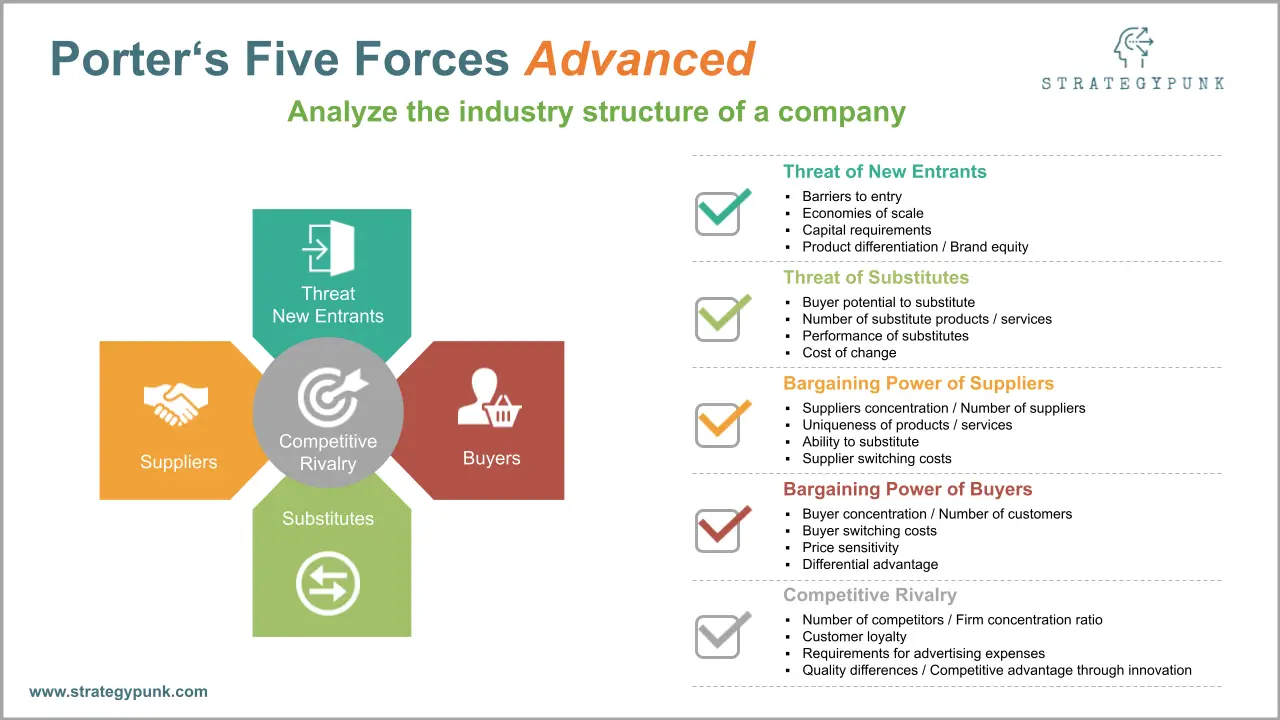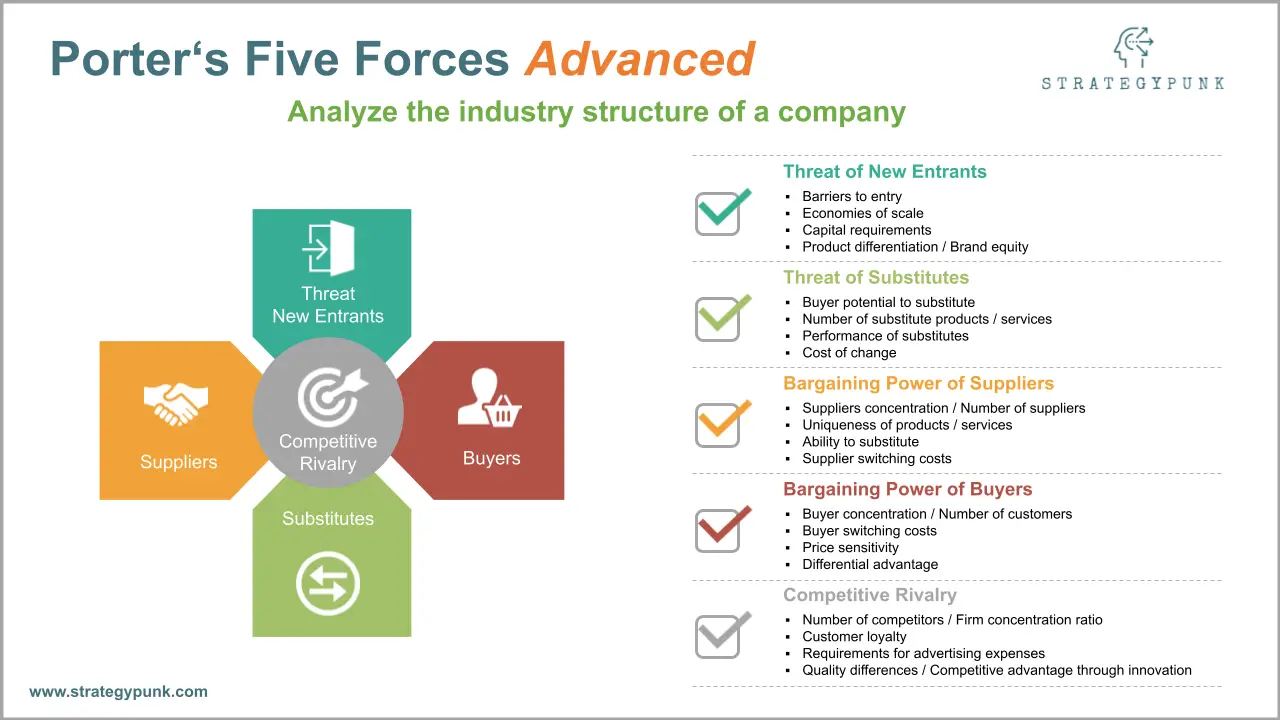Michael E. Porter Five Forces: Free PowerPoint Template
Download our free PowerPoint template for Michael E. Porter's Five Forces Analysis. Streamline your industry analysis with our customizable slides, designed for clarity and impact.

Porter's Five Forces is a powerful and simple tool to understand the business’s environment, competition level, and, thereby, the attractiveness of a company or industry regarding its profitability.

What Are Porter's Five Forces?
Porter's five forces are a framework for analyzing the level of competition within an industry and business strategy development. It looks at five key areas:
- Threat of new entrants - How easy or difficult is it for new competitors to enter? Factors include barriers to entry like patents, economies of scale, capital requirements, switching costs, etc. The more accessible it is for new companies to enter, the more competitive the industry.
- Bargaining power of suppliers - How much bargaining power and influence do suppliers have over participants in an industry? Factors include several suppliers, uniqueness of product or service, switching costs, etc. Powerful suppliers can squeeze industry profitability.
- Bargaining power of buyers - How much bargaining power and influence do buyers have over participants in an industry? Factors include number of buyers, information availability, ability to switch suppliers, etc. Powerful buyers can force down prices, demanding higher quality and more service.
- Threat of substitute products or services - How easy is it for customers to switch to alternatives or substitutes? The presence of close substitute products limits an industry's profit potential.
- Rivalry among existing competitors - What is the intensity of competition between existing firms in an industry? Competition is higher when there are many similar-sized firms or slow industry growth rates. High rivalry limits the profitability of an industry.
Analyzing these five forces helps determine an industry or market's long-term profitability and attractiveness. Strategies can then be developed to improve competitive position.
Origin of Porter's Five Forces Framework
Porter's five forces framework was developed by Harvard Business School professor Michael E. Porter and first published in his 1979 article "How Competitive Forces Shape Strategy” in the Harvard Business Review. It has become one of the most influential and widely used business strategy tools.
The framework provides a systematic way of analyzing the structure of an industry and assessing the underlying drivers of profitability. As taught in Harvard Business School courses and applied by generations of graduates, Porter's five forces remain integral to strategic analysis and thinking today across industries.
It continues to provide business leaders and students with keen insights into assessing industry competition and developing strategies to improve their competitive positioning.
Porter's Five Forces Tool
tool helps understand the strength of the business's current competitive position and the position the business inspires to move into.
Porter's Five Forces are the threat of new entrants, the threat of substitute products/services, the bargaining power of suppliers, the bargaining power of buyers (customers), and competitive rivalry.
Understanding Porter's Five Forces
Threat of New Entrants
- Barriers to entry
- Economies of scale
- Capital requirements
- Product differentiation / Brand Equity
Threat of Substitutes
- Buyer potential to substitute
- Number of substitute products/services
- Performance of substitutes
- Cost of change
Bargaining Power of Suppliers
- Suppliers concentration / Number of suppliers
- Uniqueness of products/services
- Ability to substitute
- Supplier switching costs
Bargaining Power of Buyers
- Buyer concentration / Number of customers
- Buyer switching costs
- Price Sensitivity
- Differential advantage
Competitive Rivalry
- Number of competitors / Firm concentration ratio
- Customer loyalty
- Requirements for advertising expenses
- Quality differences / Competitive advantage through innovation
How Does Porter's Five Forces Differ from SWOT
Porter's Five Forces and SWOT analysis are two fundamental strategic planning tools that approach competitive analysis from different perspectives:
Porter's Five Forces analyzes the competitive landscape from the outside in, focusing on the industry. It examines the external threats and opportunities in an industry environment. Specifically, it looks at five fundamental forces that determine long-term profitability:
- Bargaining power of suppliers
- Bargaining power of buyers
- Threat of new entrants
- Threat of substitute products
- Rivalry among existing firms
In contrast, SWOT analysis takes an inside-out perspective, evaluating the internal strengths and weaknesses of a specific organization operating in that industry along with external opportunities and threats.
While Porter's helps understand overall industry attractiveness and competitiveness, SWOT provides more specific insights into a firm's current situation and position compared to rival companies.
In summary:
- Porter's - External industry focus
- SWOT - Internal organizational focus
Porter's and SWOT are complementary lenses providing a comprehensive view to formulate strategy and make better decisions. Savvy businesses leverage these frameworks to assess their competitive standing from different angles.
Critiques of the Five Forces
The framework provides valuable strategic insights but has some limitations.
It assumes rational profit maximization and lacks the dynamism to capture rapidly evolving industry landscapesentirelyy. The model adopts a somewhat staticview, when competition today is often more fluid and multi-dimensional across value chains.
There are also critiques regarding the measurement of the five forces. However, the Five Forces remains a simple, influential, and widely taught strategy tool to fundamentally assess industry structure and competition.
Applying Porter's Five Forces Model PowerPoint Slide
The slide is typically used in:
- business plans
- strategy plans
- marketing plans
- M&A investor decks
- corporate presentations
Alternatives to Porter’s Five Forces
Here are some alternatives to Porter's Five Forces that businesses can use to analyze their industry and competitive environment:
- PEST Analysis - PEST stands for political, economic, social, and technological factors. It helps companies assess the broader macro-environment. PEST provides a more comprehensive view compared to Porter's narrower focus on the industry.
- SWOT Analysis - SWOT stands for strengths, weaknesses, opportunities and threats. It helps identify internal company factors (strengths and weaknesses) and external environmental factors (opportunities and threats). SWOT provides a more holistic assessment compared to just examining the industry.
- Competitor Analysis - Looking deeply at current direct competitors, potential new entrants, substitute offerings, buyer power, and supplier power. This helps strategize around specific competitive threats and opportunities compared to Porter's broader industry-wide view.
- Blue Ocean Strategy - This examines how companies can launch offerings in untapped market spaces with little competition. It's an alternative to competing directly against rivals in crowded "red oceans" of existing market segments.
- Co-Opetition Analysis - This looks at interdependencies between rivals and how they can collaborate for mutual benefit instead of just directly competing. It's an alternative view to Porter's more zero-sum competitive mindset.
- Scenario Planning - Developing multiple future scenarios allows strategizing for uncertainty. This is different from Porter's implicit assumption of more static industry conditions.
The key is to combine multiple lenses and perspectives to gain a comprehensive strategic view instead of relying on just one framework like Porter's Five Forces. Each lens provides unique insights.
Michael E. Porter's Five Forces: Free PowerPoint Template
The Michael E. Porter Five Forces Analysis is a framework for analyzing the level of competition within an industry and business strategy development.
This free PowerPoint template provides a visual guide to Porter's five forces model, including rivalry, the threat of substitutes, buyer power, supplier power, and barriers to entry.





